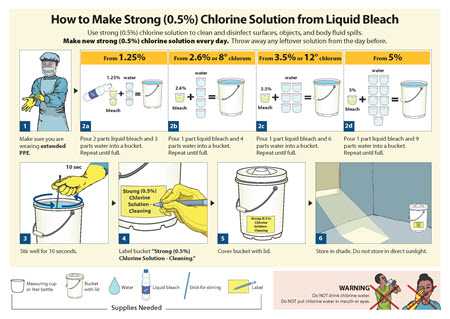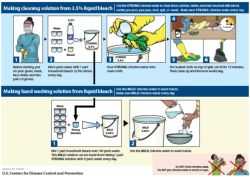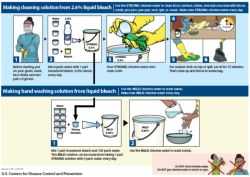Interim Recommendations for Cleaning Houses Safely in Areas in West Africa with Ebola Outbreaks After People with Symptoms of Ebola Virus Disease (EVD) are Transferred to Ebola Treatment Units or Community Care Centers
Page Summary
Who this is for: People in West Africa in areas with Ebola outbreaks responsible for cleaning the house after household members with symptoms of Ebola virus disease (EVD) are transported to an Ebola treatment unit or Ebola community care center.
What this is for: To reduce the spread of EVD among family and household members.
How to use: Use these recommendations to safely clean houses after transferral of people with symptoms of EVD to Ebola treatment centers or community care centers.
Key Points
- Only one person should be responsible for cleaning the house after someone in the household with symptoms of EVD is transferred to an Ebola treatment unit (ETU) or Ebola community care center (CCC).
- Do not touch body fluids or anything that was used by the sick person, including bed covers, plate, cup, and utensils without wearing appropriate protective gear.
Prepare Strong (0.5%) and Mild (0.05%) Chlorine Solutions
- You can make these chlorine solutions from a variety of different products
- Chlorine powder
- 5% liquid bleach
- 3.5% liquid bleach
- 2.6% liquid bleach
- If using liquid bleach to make strong (0.5%) and mild (0.05%) chlorine solutions, make sure you know what kind of liquid bleach (what percentage: 5%, 3.5% or 2.6%) you are using.
Use Protective Gear for Cleaning Procedures
- Wear heavy duty/rubber gloves and, if available, nitrile or latex gloves under the rubber gloves.
- Wear an impermeable waterproof gown or a long waste plastic bag to cover your full body.
- Wear closed shoes, ideally boots.
- Use face protection (mask and goggles or face shield) if cleaning surfaces contaminated with body fluids such as saliva, sweat, blood, feces, urine, or vomit.
- Put on these items before you start any of the cleaning procedures below.
Cleaning Procedures
For latrines used by the sick person or for blood stains, urine, vomit, or stool on the floor
-
- Pour carefully 0.5% chlorine solution on the latrine and floor using a cup or a bottle and let it sit for 15 minutes. Sprayers should not be used to avoid formation of droplets.
- If floor is visibly soiled with body fluids such as blood, urine, vomit, or stool, then use a towel to cover the soiled area and pour 0.5% chlorine solution on top of the towel to avoid splashes or dispersion of body fluid spills. Leave the towel with chlorine solution on the surface for 15 minutes.
- Remove dirty towel after 15 minutes and dispose of towel in a plastic bag.
- Clean and remove remaining chlorine solution using a towel or absorbent fabric soaked with 0.5% chlorine solution.
- Do not touch any spills of body fluids. Use a wooden stick to clean the floor using the towels or fabrics soaked with 0.5% chlorine solution.
- Rinse the floor and latrine with water and soap to reduce chlorine residues.
- Dispose of all dirty towels/fabrics in a plastic bag and burn the plastic bag containing the dirty towels/fabrics.
Chamber/Bucket used as latrines
-
- Keep the bucket that the sick person used closed.
- Carefully pour enough of the 0.5% chlorine solution into the bucket to cover the contents. Leave solution in the bucket for 30 minutes.
- Dump the contents in a latrine after 30 minutes.
- Use a clean towel or fabric soaked with 0.5% chlorine solution to clean the latrine.
- Rinse the bucket with 0.5% chlorine solution and then wash with water and soap.
Clothes, linens, towels, and mattress(es) that were in contact with the sick person
-
- Place linens, towels, or clothes that are visibly soiled with blood, vomit, urine, or feces in a plastic bag to be burned.
- Put linens, towels, or clothes that are NOT visibly soiled in a bucket with 0.05% chlorine solution. Let items soak in solution for 30 minutes and then wash normally.
- If the mattress is NOT covered with plastic sheeting, then pour 0.5% chlorine solution on mattress and burn it outside of the house with any other items that need to be burned.
- If the mattress is covered with plastic sheeting, then pour 0.5% chlorine solution on the plastic sheeting, let the solution sit for 15 minutes, remove the solution with towel, and then wash the plastic sheeting normally.
Plates, utensils, and cups
-
- Remove all plates, cups, and utensils used by the sick person.
- Throw away leftover food in a plastic bag.
- Wash plates, cups, and utensils with clean water and soap.
- Rinse plates, cups, and utensils with 0.05% chlorine solution and let them air-dry.
After Cleaning Is Complete
These steps should be done in order:
- Wash your rubber gloves with 0.5% chlorine solution.
- Use a clean towel soaked with 0.5% chlorine solution to clean your shoes/boots.
- Remove washed rubber gloves and put in a bucket with 0.5% chlorine solution for 30 minutes.
- Wash your hands, or inner pair of gloves if wearing inner gloves, with soap and water or with 0.05% chlorine solution.
- Remove waterproof gown and place it in the same bucket as the rubber gloves.
- Wash your hands, or inner pair of gloves again if wearing inner gloves, again with soap and water or with 0.05% chlorine solution.
- If wearing a mask, remove it using the ties or bands and throw it away.
- If wearing goggles, remove them without touching the front of the goggles and place them in the bucket with the gown.
- Wash your hands, or inner pair of gloves if wearing inner gloves, again with soap and water or with 0.05% chlorine solution.
- If wearing an inner pair of gloves, remove gloves and throw them away.
- Wash hands with soap and water or with 0.05% chlorine solution after removing inner pair of gloves.
- Proceed with normal washing of gown, gloves, and goggles after 30 minutes.
- Page last reviewed: February 4, 2015
- Page last updated: February 4, 2015
- Content source:


 ShareCompartir
ShareCompartir



